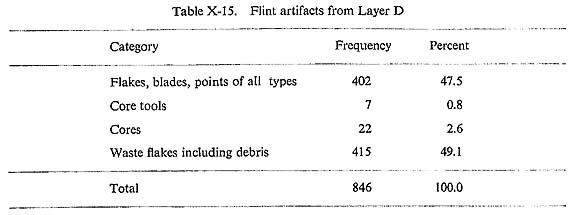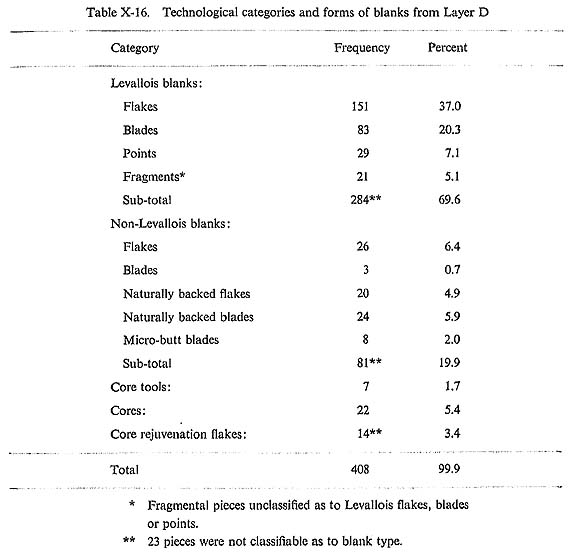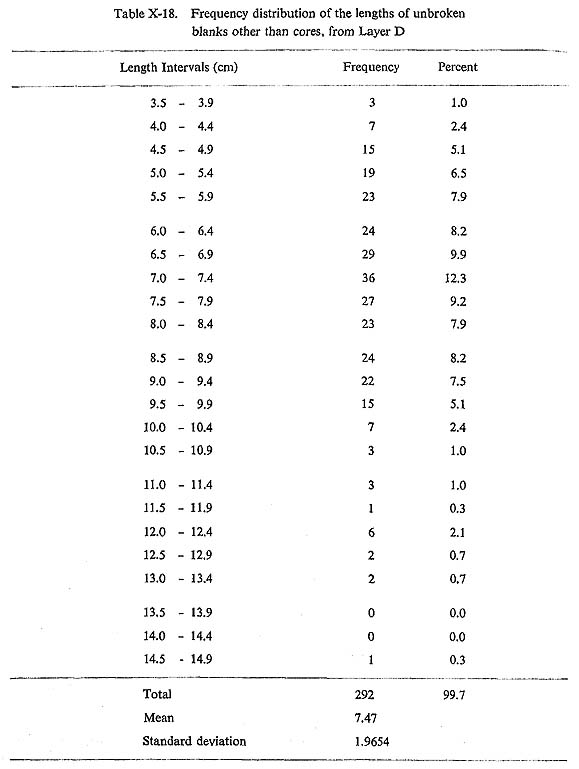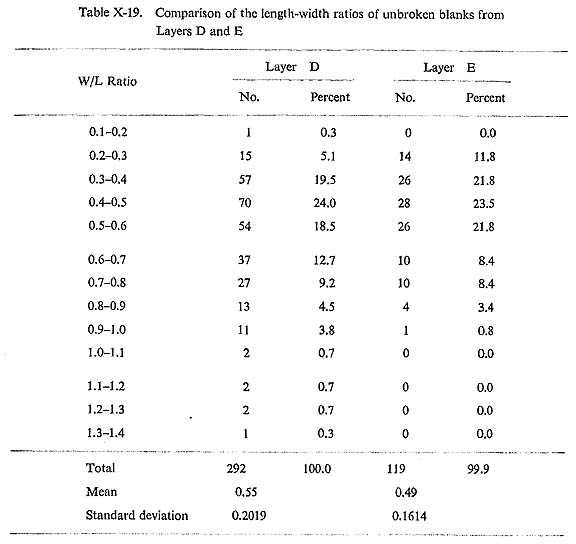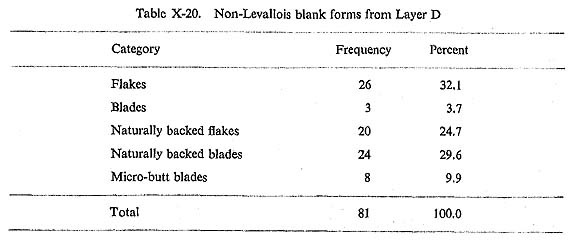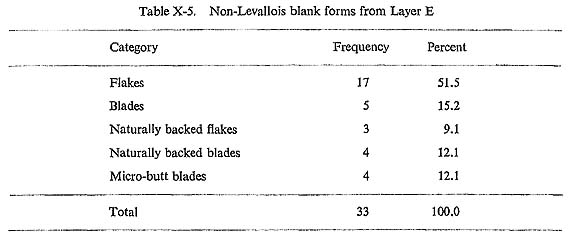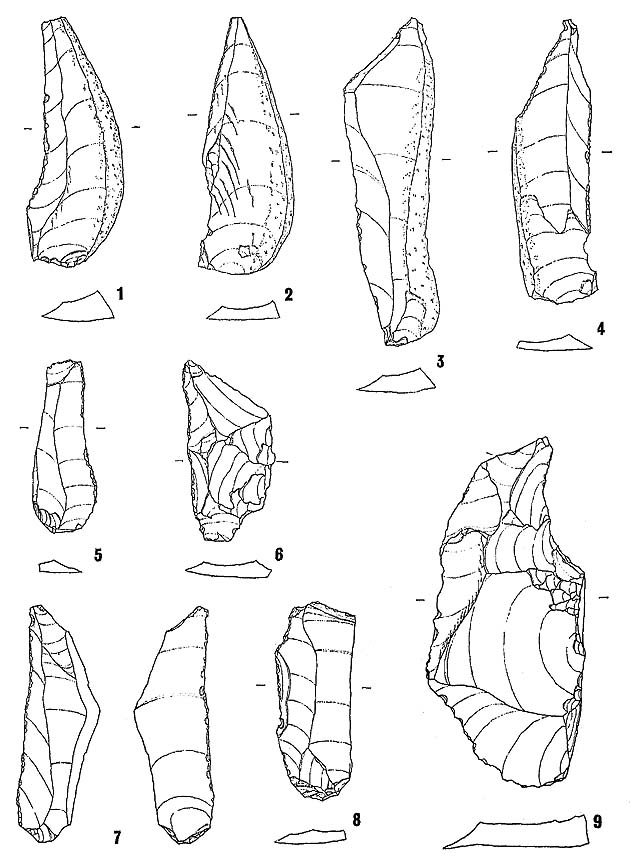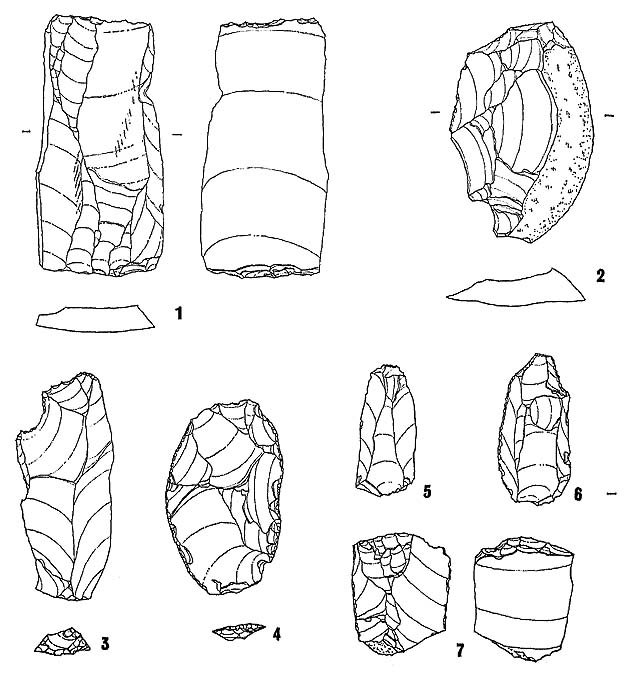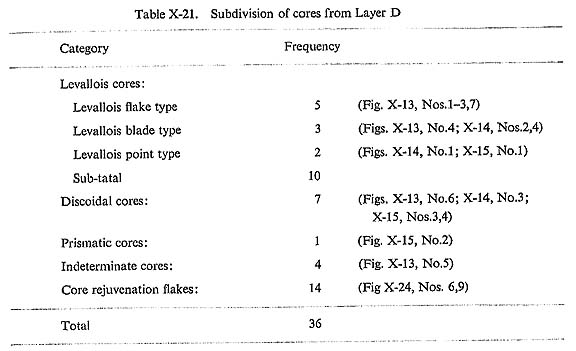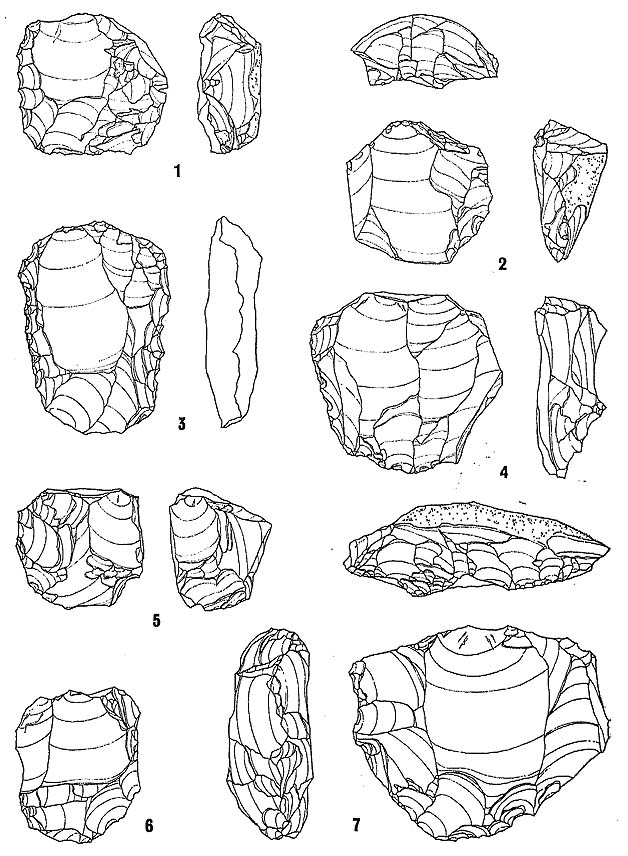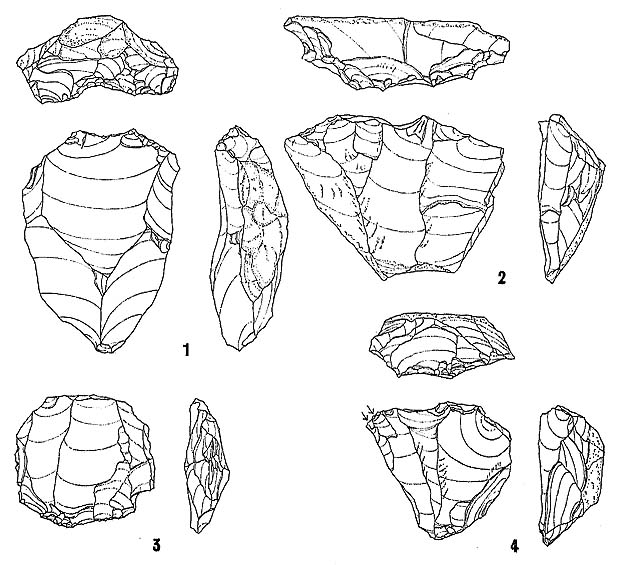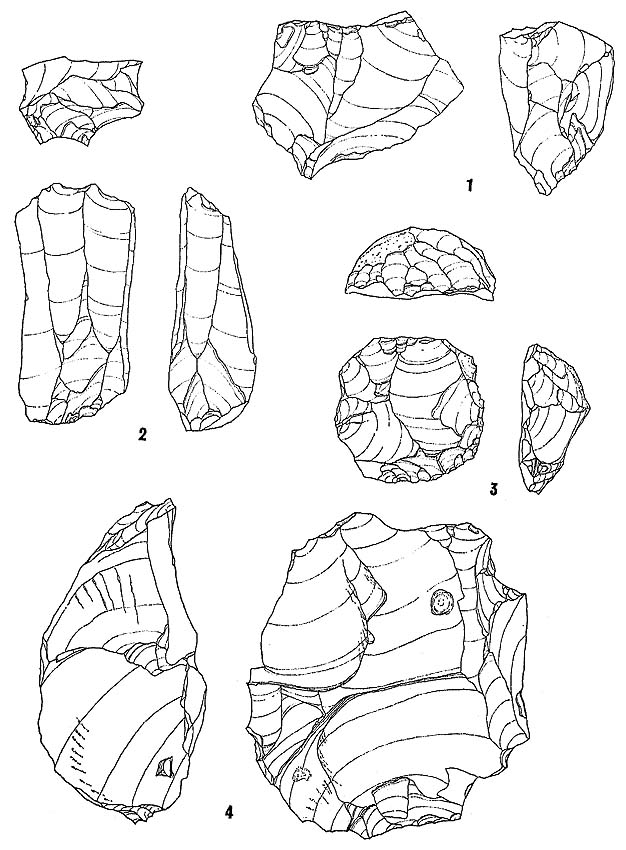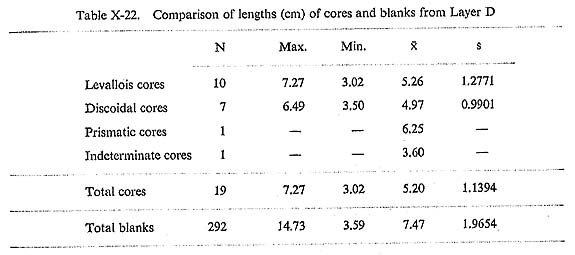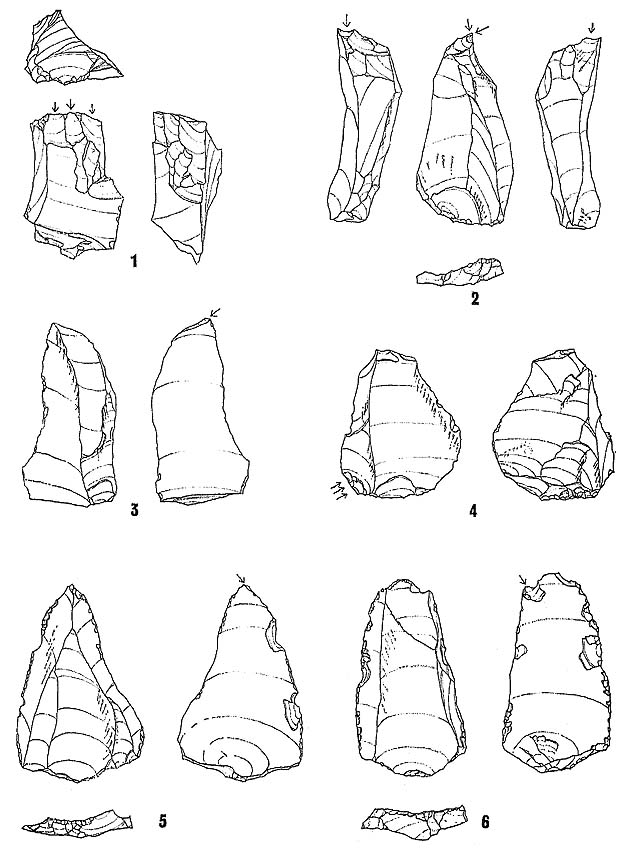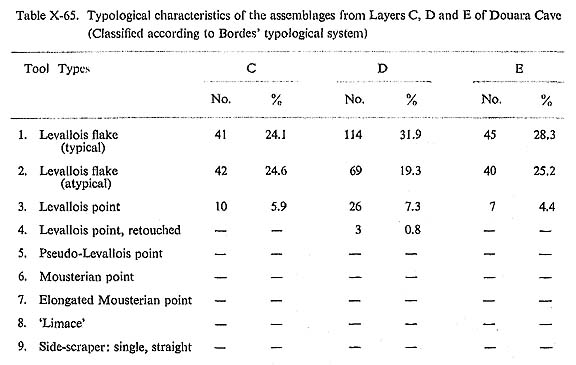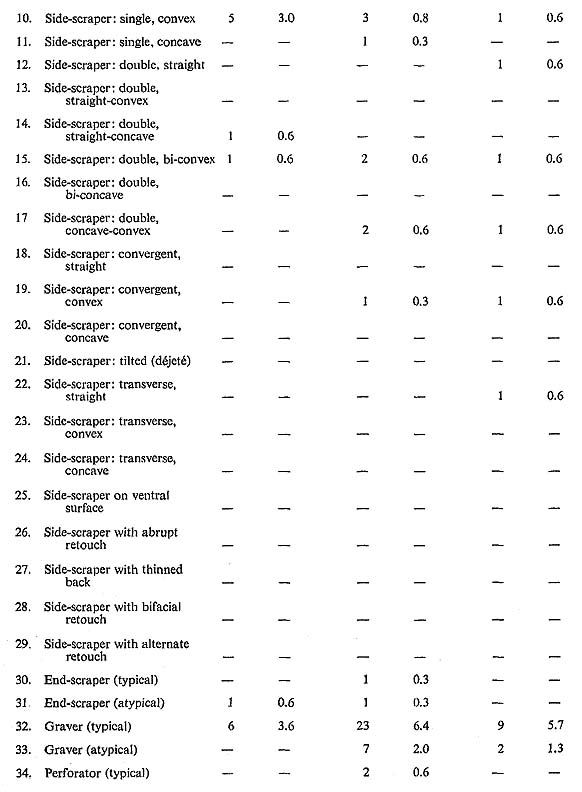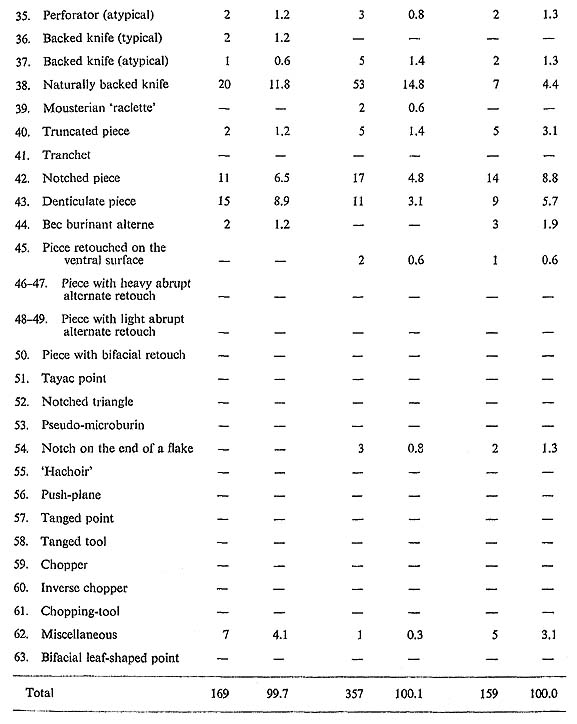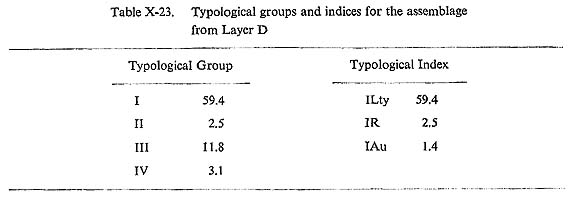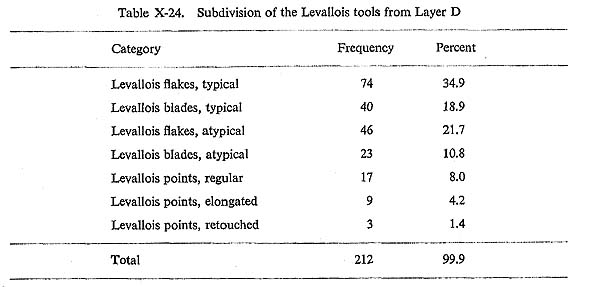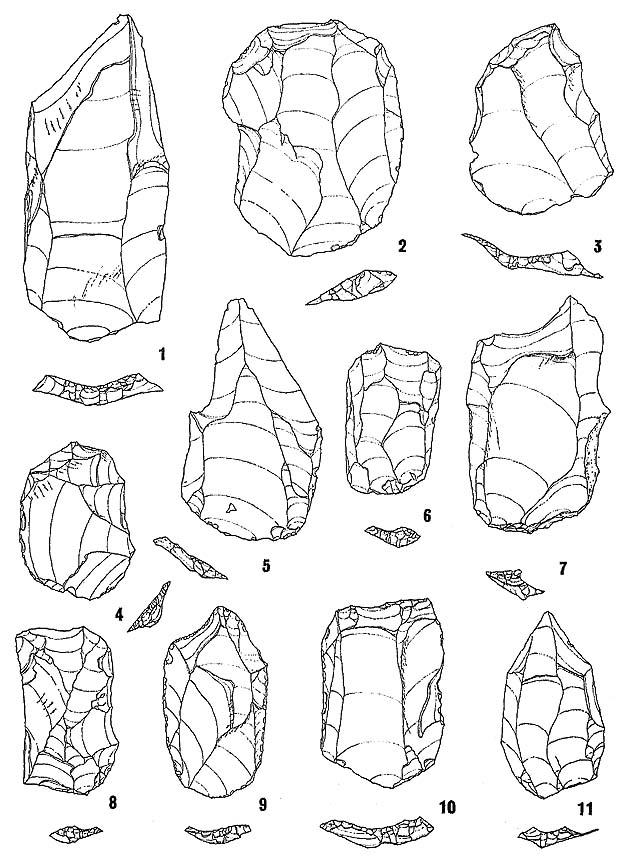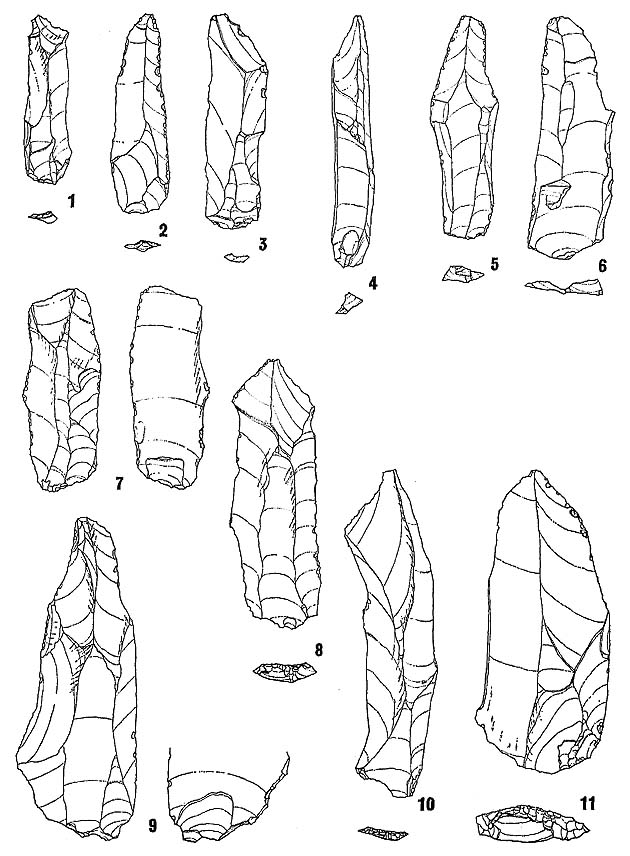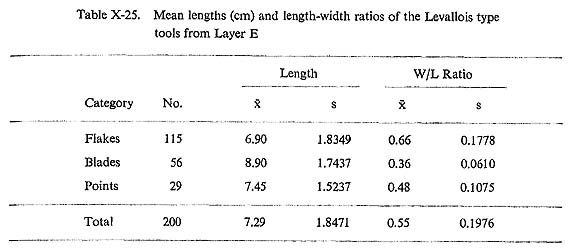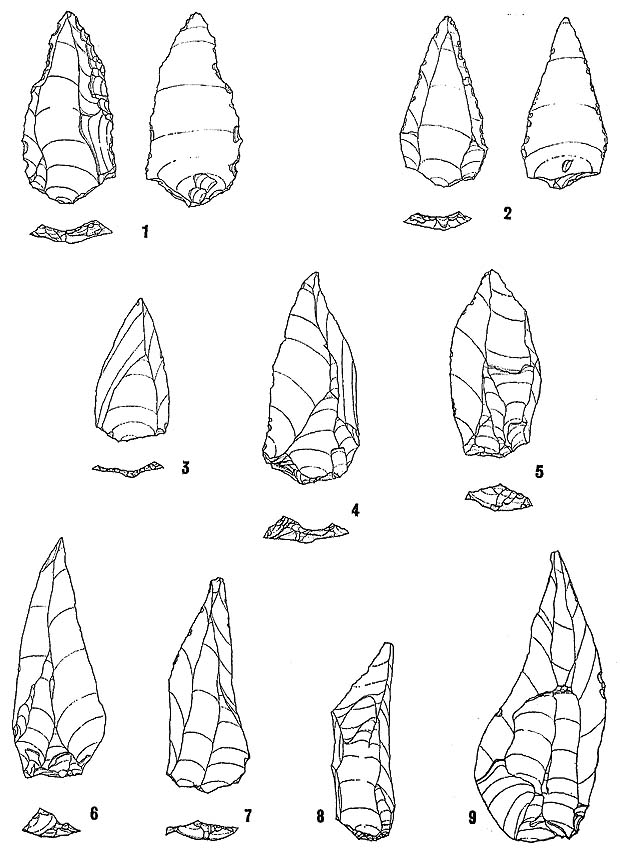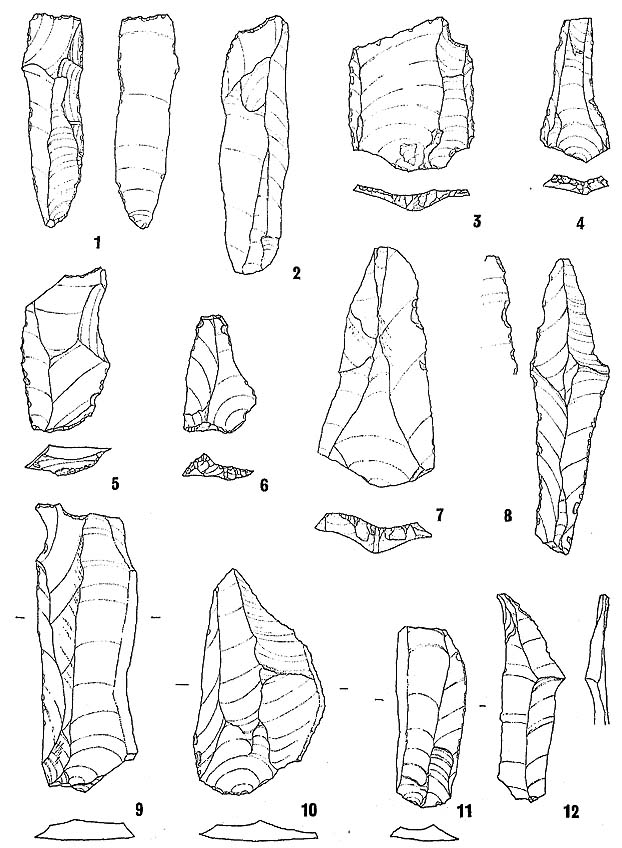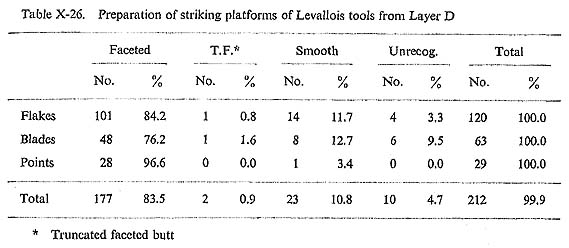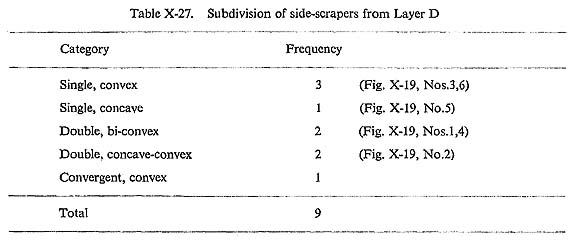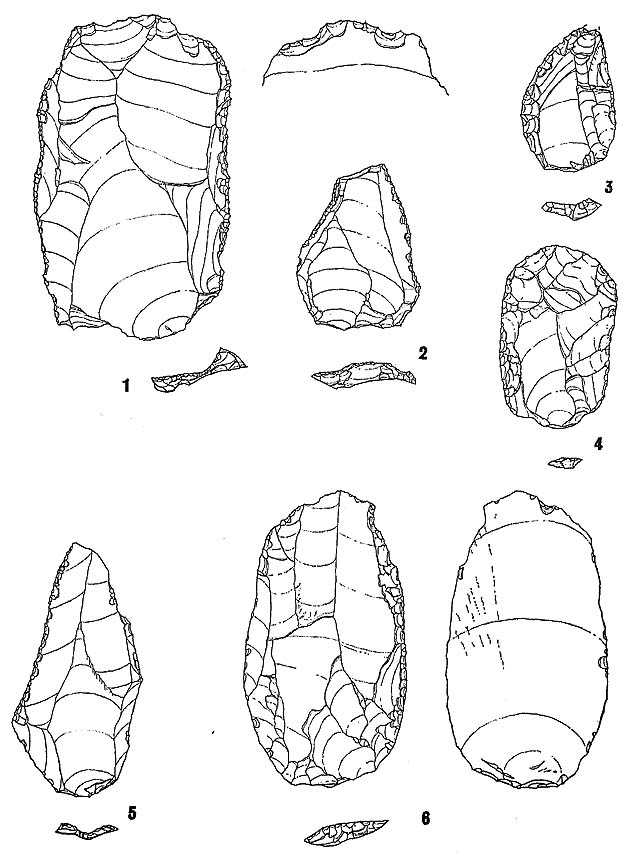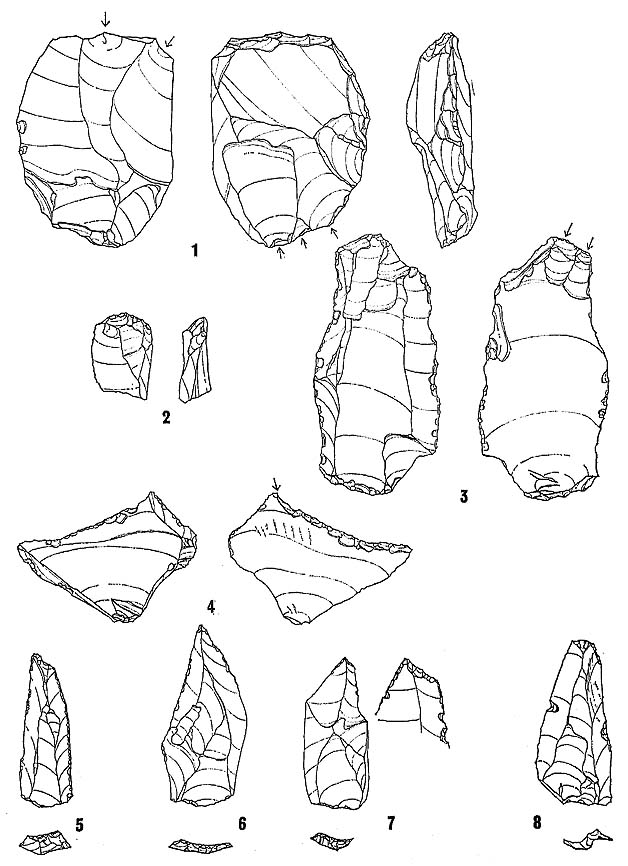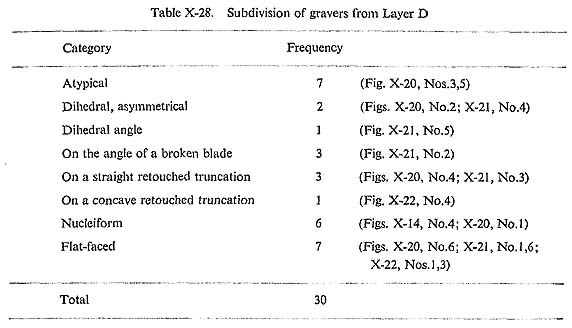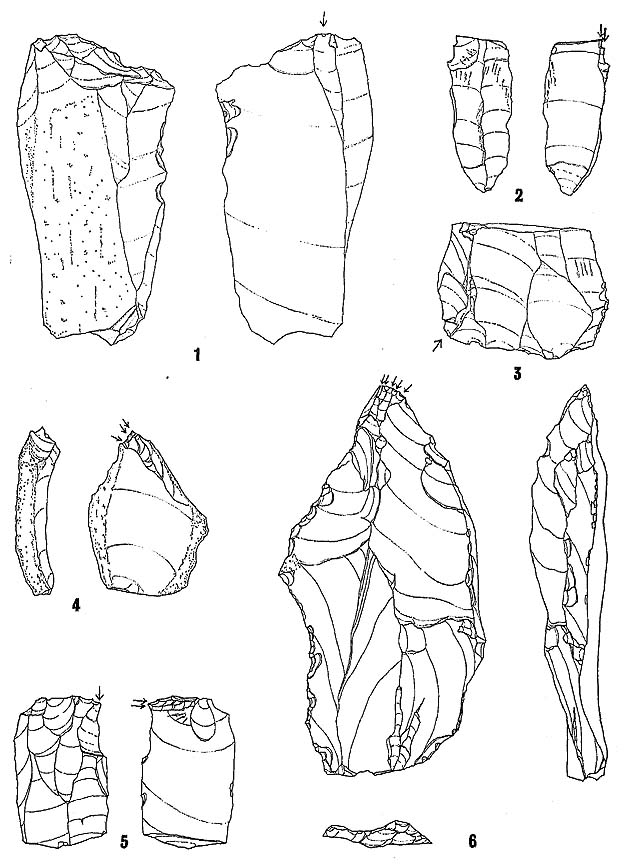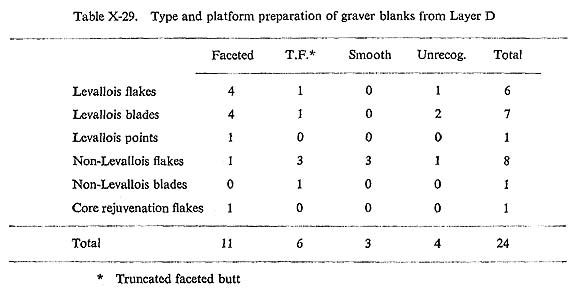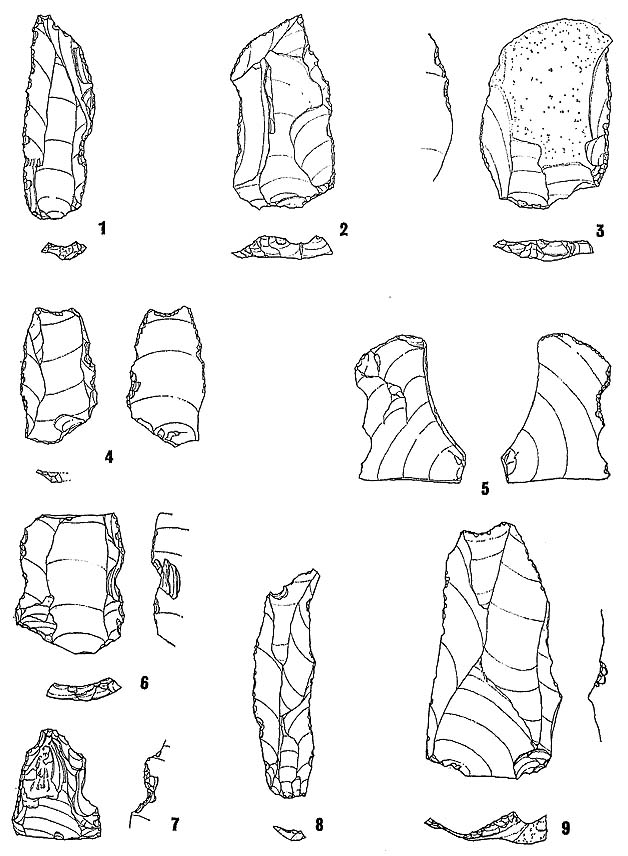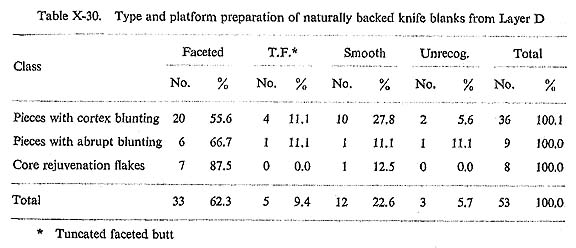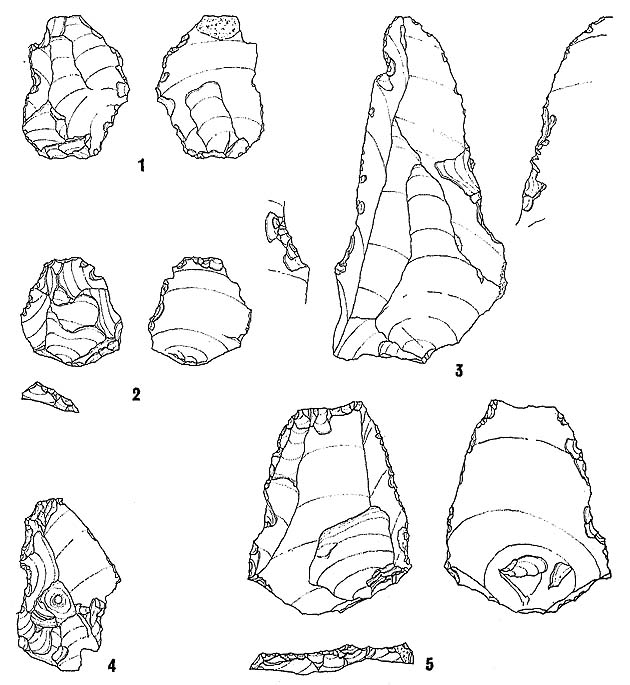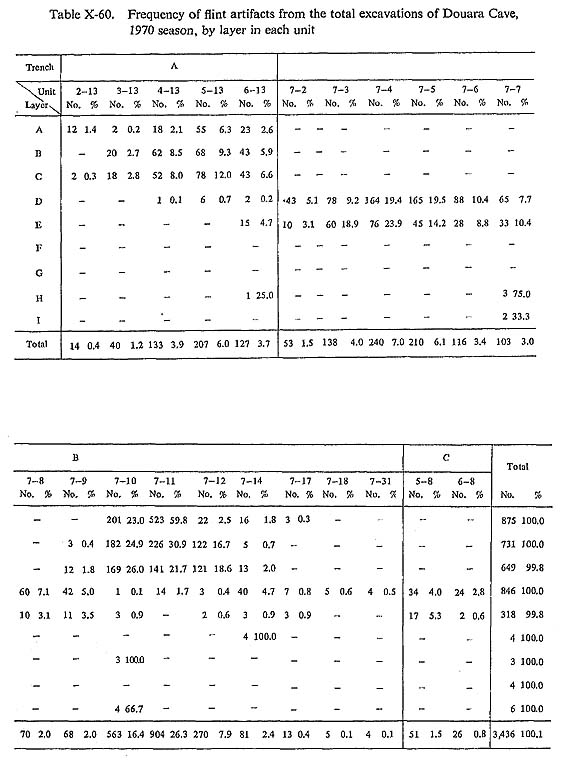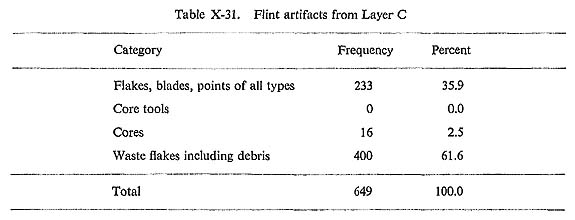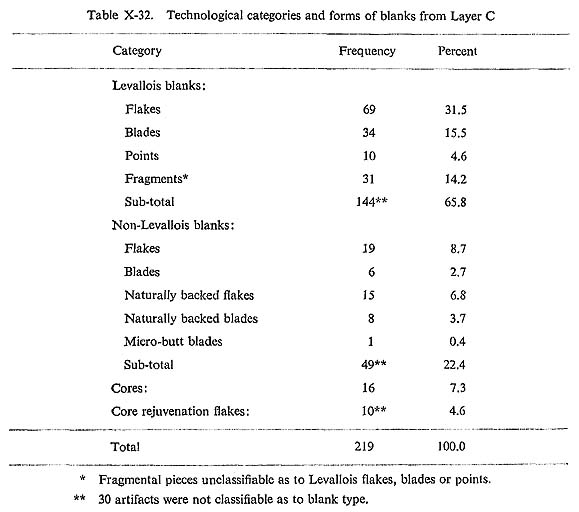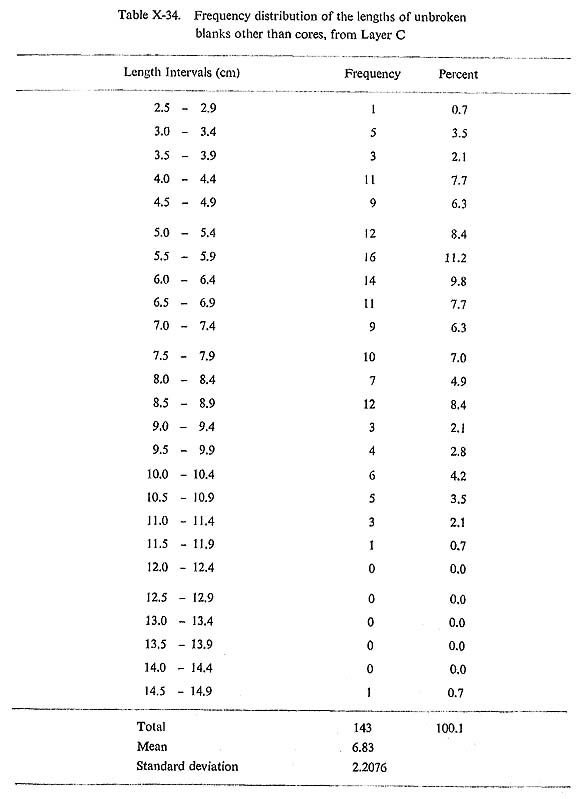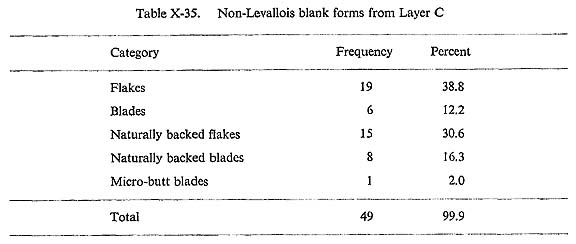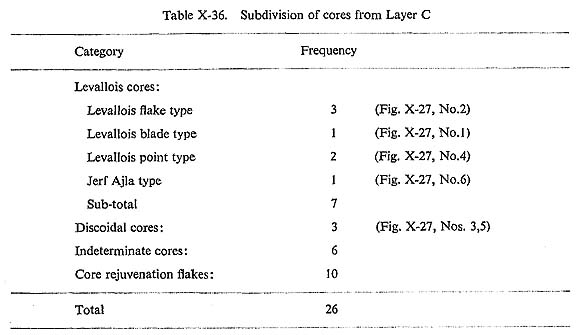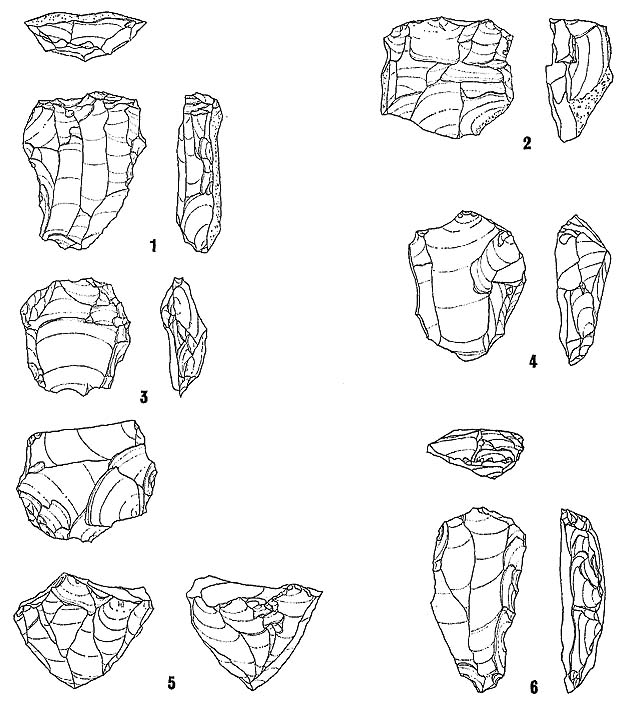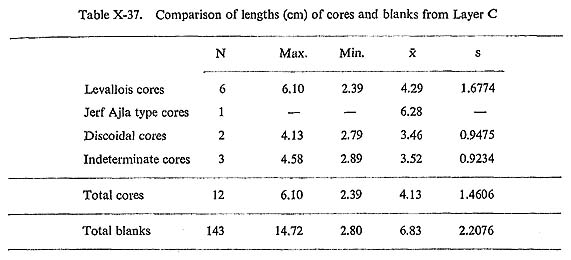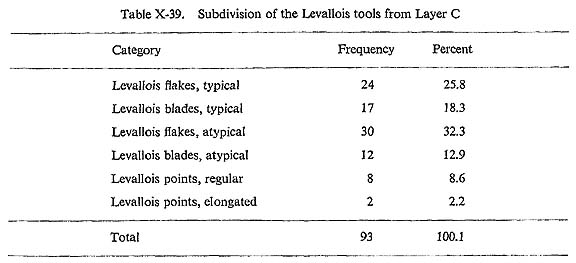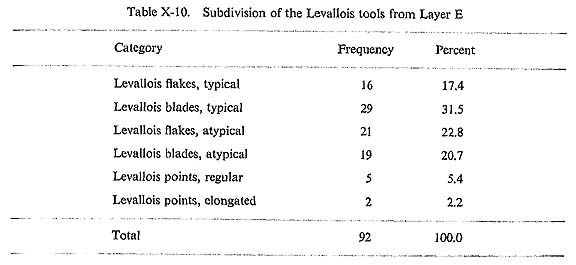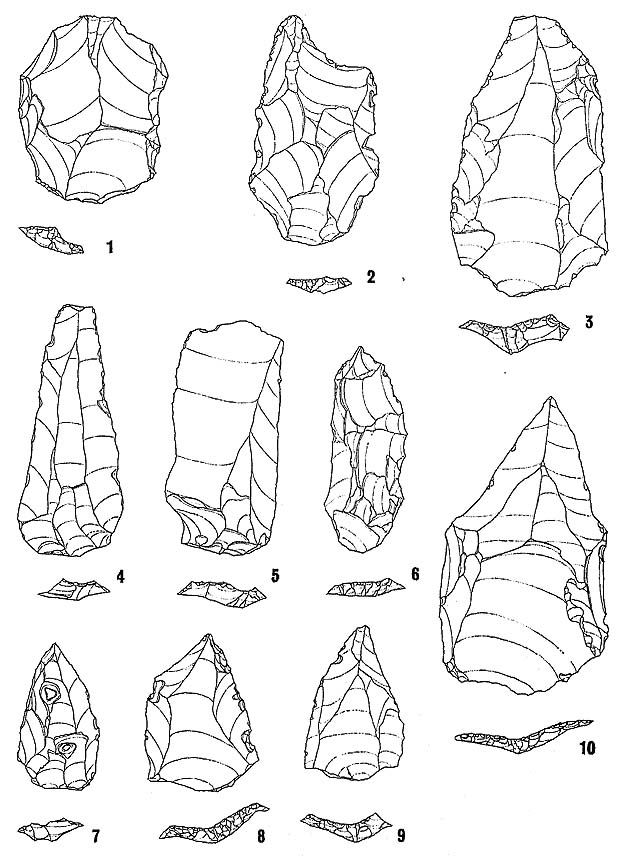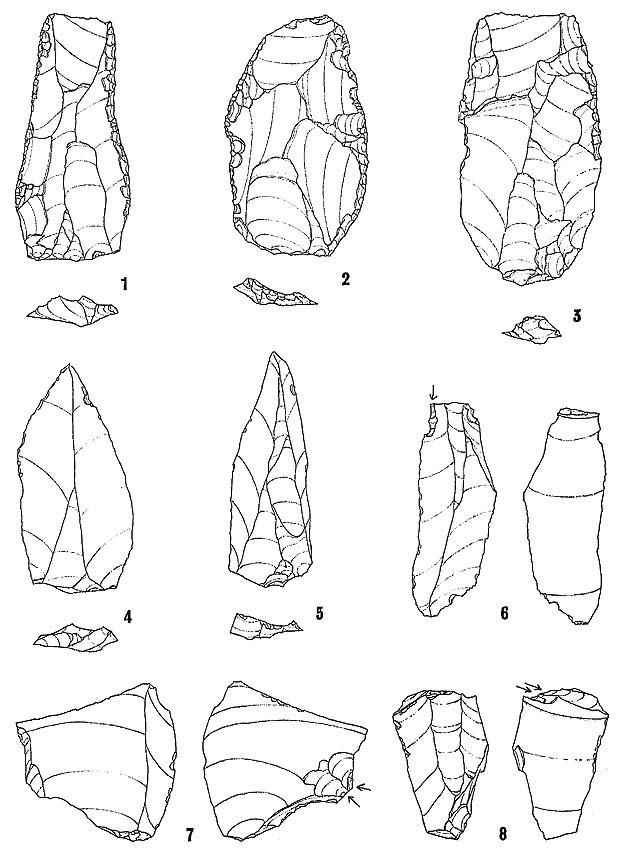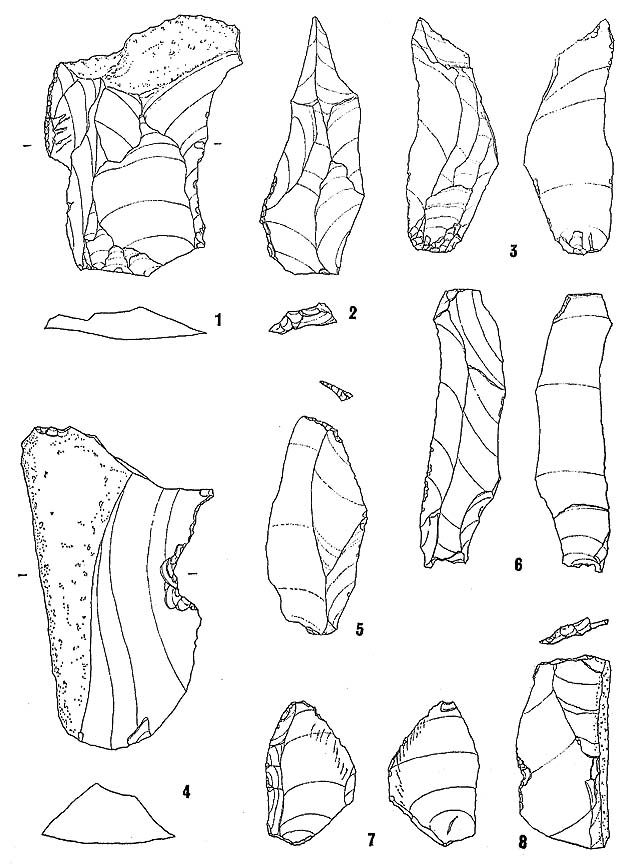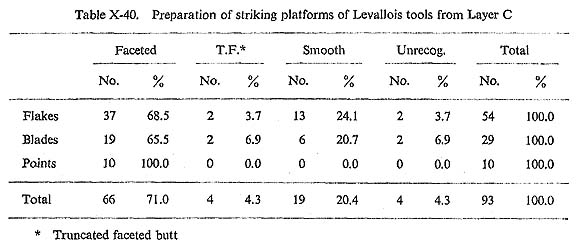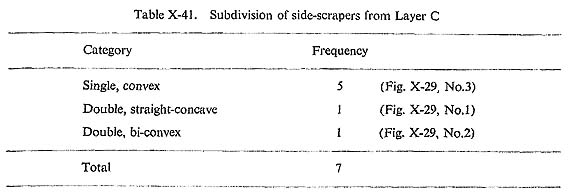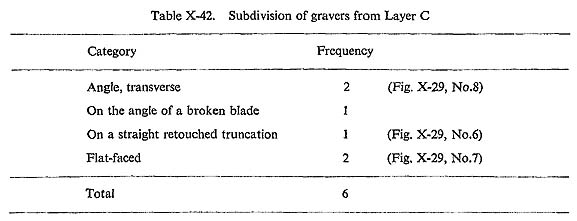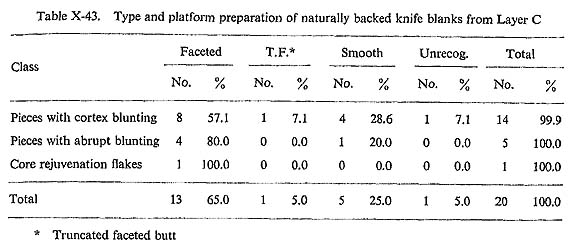CHAPTER X
PALAEOLITHIC ASSEMBLAGES FROM THE DOUARA CAVE SITE
Takeru AKAZAWA
Department of Anthropology and Prehistory, The University Museum, The University of Tokyo
| ( 3 / 7 ) |
LAYER D: MIDDLE PALAEOLITHICThe flint artifacts from Layer D were obtained from throughout the areas excavated in the 1970 season. The richest archaeological deposits in Layer D were in the interior part of Trench B (Units 7-4, 7-5), which produced a large number of flake pieces, Middle Palaeolithic in character (Table X-60). The following description of these flint artifacts is based on 846 pieces, consisting of 402 flakes, blades and points, 7 core tools, 22 cores and 415 waste pieces and other debris (Table X-15). The flint artifacts in this layer are usually brown to dark brown in color and contrast with the bluish or blackish gray artifacts in the preceding Layer E.
TECHNOLOGICAL DESCRIPTIONBlanksIn this layer, 284 blanks used to make tools are of Levallois type, 81 are non-Levallois type flakes and blades and 7 are core tools (Table X-16).
Again in this layer, the principal technological category in the assemblage is the Levallois technique, with a high index (IL) of 74.9 but showing a slight decline from the preceding layer. The Index of Faceting (IF) rises to 81.5, in the strict sense to 69.5, but the Blade Index (ILam) drops to 34.3 (Table X-17).
The last figure reflects the decreased number of blade type blanks whose length is greater than twice their width (Table X-17). However, the distribution and the mean length of the blanks of this layer closely resembles that of the preceding Layer E (Table X-18). In other words, the distributions of the lengths of blanks are nearly the same in both Layers D and E, but the proportion of elongated blanks in the assemblage in Layer D is less than that in Layer E. This technological change is also seen in a comparison of the length-width ratios of the blanks from both layers (Table X-19). The length-width ratios, showing the narrowness of blanks, are similar in both layers, but the values rise slightly from Layer E to D. This reflects the fact that the blanks become broader.
The number and the relative quantity of the non-Levallois blanks on which tools are madeb are greater than those of the preceding layer. They consist of non-Levallois flakes and blades, naturally backed flakes and blades, and micro-butt blades (Table X-20). In this layer, the naturally backed flakes and blades predominate over the non-Levallois flakes and blades, in contrast to the relationship seen in the preceding layer (Table X-5).
These naturally backed flakes and blades are produced during preparation of the peri meter of the Levallois core. They have one naturally blunt edge opposite which is a sharp cutting edge with fine, irregular flaking caused by secondary use (Figs. X-24, Nos. 1-5, 7, 8; X-25, Nos. 1, 2). The micro-butt blades have extremely tiny and smooth butts, which are in striking contrast to the butt forms of the other blanks. This form suggests that a lithic technique markedly different from the Levallois technique was employed for the production of these blanks (Fig. X-18, Nos. 8, 9).
CoresThe twenty two cores from this layer fall into five categories (Table X-21). Of these, Levallois cores are the most common (10). The Levallois cores are further divided into three subtypes based on the form of the main flaking scars indicating the type of blanks removed.
Levallois flake cores (5) are generally characterized by having the scar from one main flake removed from a single faceted platform (Fig. X-13, Nos. 1-3, 7). They are usually prepared by centripetal retouch along the margin on both surfaces, with the reverse surfaces (opposite the main flaking surface) retaining some cortex. One is unusual in being elaborately retouched on the main flaking surface (Fig. X-13, No. 3). However, this elaborate retouching is observed only on the main flaking surface and, therefore, is not secondary retouching for making a tool (a bifacially retouched scraper or a cleaver). Rather, it is for the preparation of the core.
Levallois point cores (2) are characterized generally by a single pointed scar and one face ted striking platform (Figs. X-14, No. 1; X-15, No. 1). These cores are generally pointed in outline, with elaborately prepared platforms. The preparation of the core is generally simple, and cortex is retained on most of the reverse surface.
The third category of Levallois core is a tabular, blade type core (3). These are roughly rectangular in outline, with a number of parallel flaking scars from a single platform on the main flaking surface (Figs. X-13, No. 4; X-14, Nos. 2, 4). These blade cores are not so much like the cores with bi-directional and parallel flaking described by Bordes (1961) and Schroeder (1969), as they are like the Levallois point core type described above. However, the forms of a number of the parallel scars are roughly blade-like, so these cores are classified as blade type cores. All the Levallois cores from this layer are somewhat variable, as described above, but most of them are characterized by a single faceted striking platform. This contrasts with the Levallois core types in the preceding layer, which had uni-directional flaking scars. The second most common core type is the discoidal core (7). In this layer, this category includes both a tortoise-shaped type (5) and a flat type (2). In both cases the cores are elabora tely prepared and have a number of flake scars around the perimeter of core (Figs. X-13, No. 6; X-14, No. 3; X-15, Nos. 3, 4). The flat type cores in this category have flake scars on both faces (Fig. X-14, No. 3). The last defined core type is the prismatic (1). This piece has a prismatic form and a series of parallel flaking scars from a single platform (Fig. X-15, No. 2). However, it has a flake scar in the opposite direction from the main striking platform and, therefore, might fall into the category of Levallois blade cores. The indeterminate category of cores takes in core fragments (broken pieces) and cores retaining no original features because of complete removal (Fig. X-13, No. 5). Table X-22 compares core size and blank size.
Also in this layer a number of core rejuvenation flakes were found (Table X-21). Some of these served as blanks for tools such as gravers (Fig. X-20, No. 2) or backed knives (Fig. X-24, Nos. 6, 9). The latter pieces have one naturally blunt edge opposite which is a sharp cutting edge with fine, irregular flaking caused by secondary use.
TYPOLOGICAL DESCRIPTIONOf the 846 flint artifacts in this layer, 357 are identified as tools within the Bordes' typolo gical system (Table X-65). The largest category of these tools is Levallois, and the Levallois Index is 59.4. Table X-23 shows the typological groups and indices for the tool assemblage in this layer.
Levallois Type Tools (212 pieces)The largest group of specimens classifiable as Levallois tools in this layer consists of Levallois flakes (120) and blades (63), using Schroeder's classification system (Schroeder, 1969). The remaining groups of Levallois tools are three categories of Levallois points regular (17), elongated (9) and retouched regular (3) (Table X-24).
In contrast to the preceding layer, over 60 percent of the Levallois tools in this layer are flakes and regular points. That is to say, the proportion of elongated Levallois tools (those with lengths twice than their widths) declines from that of the preceding layer. The forms of the Levallois flakes are usually oval or rectangular in outline with a faceted striking platform. These are generally described as typical Levallois flakes (Fig. X-16, Nos. 2, 4, 6-10). Levallois flakes, roughly rectangular outline with pointed tips, are also a common form (Fig. X-16, Nos. 1, 3, 5, 11). The Levallois blades resemble closely in form those of the preceding layer but are not quite so slender (Fig. X-17) (Table X-25).
Of the 29 Levallois points, the majority are regular or elongated and unretouched (Fig. X-18, Nos. 2-7). The remaining three points show evidences of more or less secondary retou ches on one margin (Fig. X-18, No. 1).
The forms of the Levallois type tools generally resemble the main flaking scars on the Levallois and discoidal cores already described. Especially, the forms of the Levallois flakes, the dominant tool type in this layer, correspond closely to the flaking scars on the Levallois cores (Fig. X-11, No.7).
Table X-26 shows the relationship between the Levallois tools and the type of preparation seen on their striking platforms.
Mousterian Type ToolsSide-scrapers (9 pieces) The side-scraper is the only category of Mousterian tools in this layer. The Index of Side-scrapers (IR) is 2.5, somewhat of a decline from that of the preceding layer. The frequency distribution of these side-scrapers within the Bordes' typological system is seen in Table X-27.
All blanks on which these side-scrapers are made are Levallois flakes with faceted butts, except two pieces unidentifiable because they are fragments. The secondary retouch used in shaping these tools falls into two categories-flat, scaled retouch (Fig. X-19, Nos. 3, 4-6) and fine, more or less semi-abrupt retouch (Fig. X-19, Nos. 1, 2). The first type is generally found on both the single and double types of side-scraper, while the second type is found only on the double type of side-scraper. The scraping edges formed by the second type of retouch are not as sharp as those formed by the first type.
The general characteristics of the side-scrapers in this layer resemble those of the preceding Layer E. Upper Palaeoliihic Type ToolsThe relative quantity of Upper Palaeolithic tools increases somewhat in this layer, the Index of Upper Palaeolithic tools (III) is 11.8. Gravers are the most abundant category and end-scrapers, perforators and backed knives are the remaining categories. End-scrapers (2 pieces) One end-scraper is typical and the other is atypical. The atypical one has a scraping edge formed by a number of semi-abrupt retouches at the distal end of a Levallois point blank (Fig. X-22, No. 8). The one classified as typical resembles the typical end-scrapers of Upper Palaeolithic assemblages, having a scraping edge formed by steep retouches at the end of a broken blade (Fig. X-22, No. 2).
Gravers (30 pieces) The graver is the most common of the Upper Palaeolithic tool types from Layer D (Table X-65). Also, the relative quantity of the gravers in the complete assemblage of classifiable tools from this layer rises to 8.4 percent. Table X-28 gives the typological subdivision of the gravers.
The types of gravers in this layer are essentially those already noted in the preceding Layer E. However, the gravers of flat-faced type and with transversal facets appear as new elements. Seven gravers are the atypical type, showing no clear chisel-like working edges made by secondary retouch (Fig. X-20, Nos. 3, 5). The graver facet on these atypical pieces might be a true working edge formed intentionally or false facet produced accidentally by secondary use. Two gravers are the dihedral, asymmetrical type. One of them has spalls removed on the dorsal surface across the distal end of a core rejuvenation flake, roughly perpendicularly to its long axis (Fig. X-20, No. 2). The other one has a working edge formed by spalls removed on the ventral surface at the distal end of a flake retaining cortex on the reverse surface (Fig. X-21, No. 4). Another graver is a dihedral angle type, having a working edge formed by the intersection of spalls removed perpendicularly and longitudinally to its axis at the proximal end of a flake (Fig. X-21, No. 5). One graver is characterized by a working edge formed by the intersection of the spall with the snapped edge of a broken blade (Fig. X-21, No. 2).
The gravers with working edges formed by the intersection of a facet with a retouched truncation, fall into two subtypes-on a straight retouched truncation (3) and on a concave retouched truncation (1). The former type is generally characterized by having a working edge formed by the intersection of a graver facet with a straightly retouched truncation (Figs. X-20, No. 4; X-21, No. 3). The spall forming the graver facet is observed either on the dorsal surface (Fig. X-21, No. 3) or on the ventral surface (Fig. X-20, No. 4) of the flake. The other type is unusual in having a transversal facet removed parallelly along a concavely retouched truncation on the distal end of a non-Levallois flake (Fig. X-22, No. 4). Six gravers are nucleiform with a number of adjacent facets removed forming a working edge at the end or the striking platform of a Levallois core (Fig. X-14, No. 4) or prismatic type core (Fig. X-20, No. 1). Seven gravers are of the flat-faced type with the spalls removed from the surface of a flake. This type graver has three subtypes: one type (3) is characterized by having the graver facets removed from the dorsal or ventral surface at the distal end of a flake (Figs. X-20, No. 6; X-21, No. 6; X-22, No. 3); a second type (3) is characterized by the unusual feature of having the negative bulb removed by several flat-faced retouches (Fig. X-21, No. 1); and the third type (1) is unusual in having working edges formed by the intersections of several flat faced spalls with retouched truncations at both ends of the thick flake (Fig. X-22, No. 1). The flake blanks on which the gravers have been made are listed in Table X-29.
Perforators (5 pieces) The perforators are subdivided into atypical and typical. All pieces have a projection tip at the distal end of a flake and are formed by secondary retouch. The projection tip of the atypical type (3) is formed by intensive but small, scaled retouch and is, therefore, not so prominent (Fig. X-22, Nos. 6, 7). The projection tip of the typical type (2) is formed by inten sive and extensive retouch at the distal end of a flake and is prominent (Figs. X-22, No. 5; X-23, No. 1). The blanks of all the perforators are Levallois type-one flake and four blades. The secondary retouch forming the projection tip is usually only on the dorsal surface with no alternate retouch on the ventral surface. One perforator is a composite tool, with a notched element (Fig. X-23, No. 1).
Backed Knives (5 pieces) The last Upper Palaeolithic type tool is the backed knife (5). These are all of atypical type with abrupt blunting retouch along the lateral margins (Fig. X-23, Nos. 2, 3). The retouch is not extensive and is seen only along part of one margin of a flake. The blanks used for these pieces are three Levallois flakes (Fig. X-23, No. 2), one non-Levallois flake (Fig. X-23, No. 3) and one core rejuvenation flake. Miscellaneous Tool CategoriesNaturally Backed Knives (53 pieces) This category is the second most prominent tool type in this layer, next to the Levallois type tools. These tools are generally characterized by the presence of a naturally blunt edge along one margin, of a flake or blade and a naturally sharp cutting edge along the other margin. The cutting edge is straight, concave, or convex, and has extensive traces of secondary use. These knives are subdivided into three class based on the form of the blank upon which the tool is made. The most common type consists of those pieces with blunted edges bearing cortex of the original nodule (Figs. X-24, Nos. 1-4; X-25, No. 2). The forms of this type correspond to the shapes of the flaking scars around the perimeters of Levallois type or pris matic type cores. Accordingly, it is probable that they are originally the waste flakes or blades produced in the preparation of the Levallois cores but are later used as tools. The second type has a blunted edge that results from the flake being removed from along the abrupt edge of a core, e.g. Levallois blade type or prismatic type cores (Figs. X-24, Nos. 5, 7, 8; X-25, No. 1). The final type is a core rejuvenation flake (Fig, X-24, Nos. 6, 9). Table X-30 gives the number in each class of the naturally backed knife and indicates the type of butt preparation.
Mousterian Raclettes (2 pieces) These pieces are characterized by extensive patches of fine, abrupt retouch along one or both margins of a flake. One piece is extensively retouched on the dorsal surface around most of the margin of a Levallois flake (Fig. X-25, Nos. 4, 6). Although it gives the impression of having been made as a side-scraper, the retouch is too steep to form a scraping edge. The second piece is formed with partial, abrupt retouch, and is made on a micro-butt blade (Fig. X-25, No. 5). Truncated Pieces (5 pieces) These pieces have regular, abrupt retouches on varying portions of their margins. Three pieces are truncated at the base of flakes: two are truncated straightly by extensive, abrupt retouch on the ventral surface, and their bulbar surfaces are completely removed (Fig. X-25, No. 7); the third piece has a concave truncation on the ventral surface of a broken Levallois type blank. A fourth piece has an oblique truncation at the distal end of a Levallois blade (Fig. X-25, No. 3). And the fifth piece has a concave truncation at the distal end of a Levallois blade with a truncated, faceted butt. Notched Pieces (17 pieces) These tools are fairly abundant in this layer. They have a single notch on at least one margin (Fig. X-23, Nos. 5-9). The notches are formed by a series of regular, abrupt retouches. The extent of the notch is considerably variable. The blanks on which these are made, consist of Levallois flakes (4) and blades (4) and non-Levallois pieces. Denticulate Pieces (11 pieces) All these pieces have a series of well-made notches or a contiguous series of large abrupt retouches along one or both margins. Most of these retouches are quite irregular and usually abrupt. The extensiveness of the working edges is considerably variable: four pieces are characterized by being irregularly retouched on both surfaces along most of the margin (Fig. X-26, Nos. 1, 2, 5), one piece has the working edge made by alternating retouch along both edges (Fig. X-26, No. 3); and six pieces are retouched only on one surface along one margin (Fig. X-26, No. 4). One of this last group morphologically resembles a denticulated end-scraper. The blanks used for these tools are five Levallois flakes and one blade, three non-Levallois flakes, and two unclassifiable broken flakes.
Pieces Retouched on the Ventral Surface (2 pieces) These pieces are characterized by semi-abrupt retouch on the ventral surfaces along one or both edges of a Levallois blade. The retouch is regular and clearly intentional. Notches on the End of a Flake (3 pieces) These pieces have a concave notch formed by fine, regular retouch on the distal end of a flake (Fig. X-23, No. 4). The blanks for these tools are two Levallois flakes and one non-Levallois flake. Miscellaneous Pieces (1 piece) This is a retouched piece; however, it is not classifiable into the other tool types described by Bordes. LAYER C: MIDDLE PALAEOLITHICThe flint artifacts from Layer C, the uppermost Middle Palaeolithic deposit at Douara Cave, are from 4 units in Trench A and 5 units in the outer end of Trench B (Table X-60). The following description of the lithic remains is based on 649 pieces, consisting of 233 flakes, blades and points, 16 cores and 400 waste pieces and debris (Table X-31).
The flint artifacts in this layer are usually patinated, gray and bluish or blackish gray, and more or less abraded. The most striking feature of the flints is that varying amounts of calcareous concretions adhere to the surfaces of a large quantity of them, in contrast to the fine, clean flints of the underlying Layers D and E. TECHNOLOGICAL DESCRIPTIONBlanksOf the unbroken, classifiable blanks in this layer used for making tools, 144 pieces are Levallois and 49 pieces are non-Levallois type flakes and blades (Table X-32).
The principal technological characteristic of the assemblage is the dominance of the Levallois technique in the production of tool blanks. This is clearly seen in the high Levallois Index (IL), 72.2. The Faceting Index (IF) is also high, 70.9, or in the strict sense 60.5 (IFs). On the other hand, the relative quantity of blades (elongated flakes whose lengths are twice than their widths) is low-the Blade Index (ILam) is 30.2 (Table X-33).
The mean length of the flake blanks is almost the same as that for the preceding layer. The frequency distribution of the lengths of the flake blanks is given in Table X-34.
Other types of blanks are non-Levallois flakes (19) and blades (6), naturally backed flakes (15) and blades (8) and blades with extremely tiny butts (1) (Table X-35).
Naturally backed flakes and blades are the most abundant, as in the preceding Layer D. The forms of these naturally backed pieces show the same features as those of the preceding layers. CoresThe sixteen cores from this layer fall into three categories-Levallois cores (7), discoidal cores (3) and indeterminate type cores (6). The Levallois cores are further divided into three subtypes, based on the form of the main flaking scars on the upper surfaces of the cores. The quantity of each subtype of Levallois cores is shown in Table X-36. They are generally characterized by having cortex on the reverse surface (opposed of the main flaking surface), and single or bi-directional flaking scars from faceted striking platforms, on the upper surfaces (Fig. X-27, Nos. 1, 2, 4). These Levallois cores show basically the same characteristics as those of the preceding layers, especially of Layer D except one specimen which shows the same features as the core designated the Jerf Ajla type by Schroeder (1969: 221). This type core is characterized by having a triangular outline with lateral margins indented by a series of abrupt notches (Fig. X-27, No. 6). On the upper surface are a number of uni-directional, parallel flaking scars. The striking platform is prepared and forms an angle less than 90°. The forms of the flaking scars resemble those of Levallois blade cores, and this core might in fact belong to that type.
Three cores are classified as discoidal and are characterized by a discoidal shape with a number oflakes removed centripetally around the perimeter of the core (Fig. X-27, Nos. 3, 5). The remaining six cores are all fragmentary examples (broken pieces) and are classified as indeterminate. The most striking features of the collection of cores from this layer is the small size of the cores and the large quantity (6) of fragmental, broken specimens. The smallness of the cores may mean that blanks were removed continuously until the core became reduced in size.
TYPOLOGICAL DESCRIPTIONOf the 649 flint artifacts from this layer, 169 are classifiable as tools (Table X-65). Most of these are Levallois type, as is seen in the Index of Levallois tools (ILty) of 55.0. The remaining tools are Mousterian, Upper Palaeolithic and miscellaneous type tools including denticulates. Table X-38 shows the typological groups and indices obtained from the total of specimens classifiable as tools.
Levallois Type Tools (93 pieces)The Index of Levallois Typology (ILty) is 55.0, somewhat of a decline from that of the preceding layer. These Levallois tools consists of flakes (54), blades (29) and points (10). Table X-39 shows the classification of these tools according to Schroeder's classification system.
The relative quantities of regular or flake types and elongated or blade types of Levallos tools are nearly the same as those of the preceding Layer D, but clearly differ from those of Layer E (Table X-10). Over 60 percent of the Levollois tools in this layer are reguar or flake type, and these generally resemble those in the preceding layer-they are oval, rectangular and rectangular with pointed tip (Fig. X-28, Nos. 1-3, 10). Further, the Levallois blades are not so slender as those in Layer E but are nearly the same as those in Layer D (Figs. X-28, Nos. 4-6; X-30, No. 6). The Levallois points do not include any retouched pieces; they consist of eight regular type (Figs. X-28, Nos. 7-9; X-29, No. 4) and two elongated type (Fig. X-29, No. 5). Most are symmetrical and well formed.
Table X-40 gives a quantitative breakdown of the butt preparation of this tool class.
Mousterian Type ToolsSide-scrapers (7 pieces) Side-scrapers are the only category of Mousterian tools in this layer. The Index of Sidescrapers (IR) is 4.1, somewhat of a rise from the preceding Layer D. The subtypes and quantities of side-scrapers in this layer are presented in Table X-41.
All these scrapers are made on Levallois blanks-six of them have faceted butts, and one is broken and without a striking platform. The retouch forming the scraping edges is of two types: flat, scaled retouch Forming a very flat, sharp working edge and a rather fine, semi-abrupt retouch. The single-edged sidescrapers are more common in this layer than in the preceding Layers D and E. Several of them exhibit small patches of retouch (Fig. X-29, No. 3). Upper Palaeolithic Type ToolsThe relative quantity of Upper Palaeolithic tools declines somewhat in this layer-the Upper Palaeolithic Index (III) is 7.1. These tools consist of one end-scraper, seven gravers, two perforators and three backed knives. End-scrapers (1 piece) This piece is atypical. It has a scraping edge formed by a series of semi-abrupt retouches. at the distal end of a non-Levallois flake with a smooth butt. However, the working edge is not clearly rounded because the retouch covers only a small part of the distal end of the flake. Gravers (6 pieces) Gravers are the most dominant category of Upper Palaeolithic tool in this layer. The gravers are subdivided based on the morphological features of the graver facets (Table X-42).
Two dihedral angle gravers are characterized by having chisel-like working edges formed by the intersection of a facet retouched transversally to the abrupt edge of a flake (Fig. X-29, No. 8). One angle graver has a working edge made by the intersection of a facet with the snapped edge of a broken blade. The fourth angle graver has a facet intersecting with a straight, retouched truncation at the base of a Levallois blade (Fig. X-29, No. 6). Two other gravers, subclassified as the flat-faced type, are characterized by having one or two spalls removed from the ventral surface of a flake and a working edge formed by the intersection of a facet with the abrupt edge of a flake (Fig. X-29, No. 7). Perforators (2 pieces) Both pieces are classified as atypical, because the projection tip is formed at the distal end of a flake and is made by crude or not so extensive retouch, and is not prominent (Fig. X-30, No. 3). The blanks for these tools are non-Levallois pieces. Backed Knives (3 pieces) The remaining Upper Palaeolithic Type tools are backed knives characterized by a blunted edge along a lateral margin. Two are typical pieces with abrupt blunting retouch along one margin: one of them has the blunted edge along the proximal part of the left side of a Levallois blade (Fig. X-30, No. 2), and the other one has the blunted edge along part of one margin of a non-Levallois flake with cortex left on the distal part (Fig. X-30, No. 1). The third backed knife is an atypical type with the blunted edge consisting of natural backing and abrupt retouch along one margin of a non-Levallois flake with a truncated, faceted butt. Miscellaneous Tool CategoriesNaturally Backed Knives (20 pieces) This is the second largest category of tool in this assemblage. These tools are generally characterized by having a naturally blunted edge along one margin and a naturally sharp scraping edge along the other margin. These characteristics are the same as those of the naturally backed knives in the preceding Layer D. These tools have three different blank forms, as described for the same tool in the preceding layer-those with a blunted edge consisting of the cortex of the original nodule (14), an abrupt edge of the core (5) or an abrupt edge of a core rejuvenation flake (1). Table X-43 shows the quantity of each type of naturally backed knife and its butt preparation system.
Truncated Pieces (2 pieces) These two pieces have an oblique or straight truncation at the distal end of a non-Levallois flake. One piece has a faceted striking platform and a naturally sharp edge opposite the blunt edge (Fig. X-30, No. 5). The other is a non-Levallois piece with a smooth butt and a notched element on its naturally sharp edge (Fig. X-30, No. 8). Notched pieces (11 pieces) These pieces have at least a single notch on one margin. Although the quantity of this tool is fairly high in this layer, well-made pieces are relatively few (Fig. X-30, No. 4). Three of the pieces are made on Levallois blanks (2 flakes and 1 blade), and the other eight pieces are made on non-Levallois flakes and blades (including 2 naturally backed pieces) and on broken flakes and blades. Denticulate Pieces (15 pieces) The relative quantity of this category is greater than in the preceding layer. All specimens have a series of well-made notches or a contiguous series of large, abrupt retouches forming an indentation along one or both edges of a flake. The notches or large, abrupt retouches are generally observed on the ventral surface on a single margin of a flake. Of these 15 pieces, five are made on Levallois flakes, six are on non-Levallois flakes and the remainder are on broken pieces. Bacs Burinantes Alternes (2 pieces) These two pieces have a projecting ridge formed by the intersection of two retouched edges, one edge retouched on the dorsal surface and the other on the ventral surface (Fig. X-30, No. 7). On these two examples, the ridges are not very prominent, but were created intentionally. One is on a Levallois flake blank and the other is on a broken piece. Miscellaneous Pieces (7 pieces) Included within this tool category are pieces that do not fit into the other categories; however, all specimens show more-or-less intentional retouching. The extensiveness of the retouching varies considerably. Two pieces are on Levallois flakes and the others are on broken pieces. |
